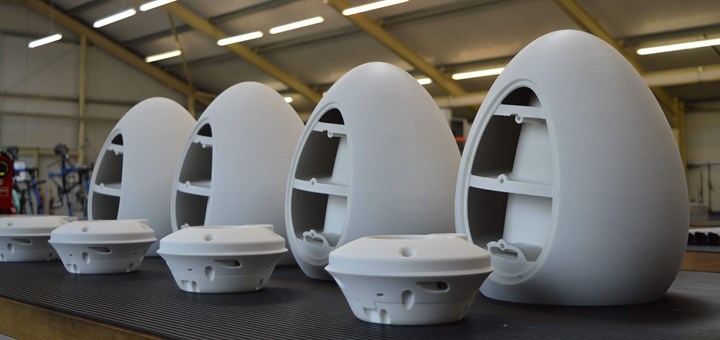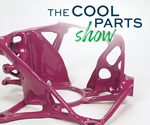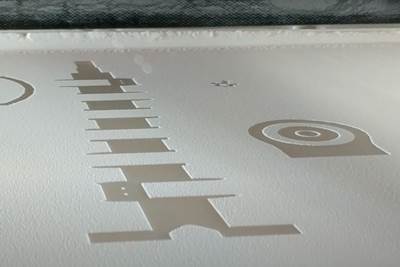In the era of wireless AirPods and personalized Spotify playlists, most of us are encountering music as an individual experience. We choose custom, private listening. We want small, portable solutions. Music travels with us, and we can form a personal oasis of sound in any public space.
But there is something lacking in these individualized listening experiences, says Ashley May, a UK-based industrial designer with a passion for high-fidelity (hi-fi) audio. “In a way I think people have lost their connection to high-quality music, to the way that the artist intended it to be heard,” he says. Together with business partner and fellow designer David Evans, May has developed a high-fidelity speaker meant to restore that connection. The Hylixa speaker, the first product from Node Audio, brings the sound range and quality of a much larger speaker into the home in a small, stylish package — a feat made possible by the design freedoms of additive manufacturing.
A Speaker That Looks as Good as It Sounds
The problem that the Hylixa solves is not without conventional solutions. The audiophile looking for a hi-fi speaker does have options, despite the contraction of the market in recent years. But the challenge is in the typical size and shape of high-fidelity speakers. Preserving the music’s bass performance usually requires a large, boxy cabinet — a design that is good for sound, but not necessarily convenient or aesthetically pleasing.
“People don’t want large, esoteric hi-fi systems in their homes,” May says. “They want something either small, discreet and hidden away, or something which is rather beautiful, that they can show off. Node Audio started off as an experiment to see if we could create something small, compact, sculptural and beautiful.”

Node Audio’s founders set out to create a high-fidelity speaker that could pack big-box sound into a compact footprint, while still looking stylish enough to be the centerpiece of a room. Photo Credits: 3D Systems
May and Evans set about designing a compact speaker that could deliver big sound while also serving as the showpiece of a room. Right away they realized that scaling down a hi-fi speaker would mean leaving behind the straight edges and corners of the typical speaker cabinet. Abandoning the traditional construction wasn’t just a space-saving tactic, though; it actually allowed them to avoid some of the acoustic challenges introduced by boxy shapes.
“With a square cabinet, you get resonances. The panels vibrate, standing waves form in the panels, and give a certain coloration to the sound. The corners create a smearing, a type of diffraction,” May says. “The starting point for us was a round speaker, because that removes all of the compromises of the square box. We [humans] don’t have square heads; when the sound leaves our mouth, it flows around the head…and you can only achieve accuracy and realism by replicating that sonic signature of a round head.”

The helical transmission line avoids corners and delivers more of the sound through the speaker for a better listening experience.
This line of thought gave them the outer form of the Hylixa speaker cabinet, an egg-shaped shell whose wide end would face out into the room to deliver the sound. But to preserve the bass performance in this small structure (less than 2 feet long), Evans and May knew they would need to do something special inside the cabinet as well.
“That led us to an acoustic geometry called a transmission line, which is essentially a path for a long acoustic channel,” May says. “But the only way to get this long acoustic channel inside the cabinet was to coil it up in a sort of seashell shape.” The cabinet design they came up with combines the outer round form with an inner spiraling transmission line that they believed would deliver a fuller range of sound to the listener.
From Simulation to 3D Printed Cabinet
But before pursuing production for the Hylixa, May and Evans had to answer one fundamental question: Would the design work?
For that, the Node Audio team enlisted the help of an acoustic engineer and specialized software that could simulate how sound would move through the speaker. According to the model, the design “proved to be a bit of a breakthrough,” May says. “We then started thinking, if this is such an advancement, how can we now create a physical product? Of course, the only way you can really accurately make this cabinet is through additive manufacturing.”
May and Evans already had previous experience using polymer 3D printing with Studio 17, the design firm where they have worked together for the past decade. “Our exposure to additive manufacturing stretches back to probably 2010 when we launched the consultancy, but we’ve always used the process as a prototyping tool predominantly,” May says. But access to a more production-oriented 3D Systems S-Pro 60 system convinced the two that selective laser sintering (SLS) could deliver on manufacturing the complex geometry they were considering.
“As designers, it’s almost like a blank piece paper,” Evans says. “Suddenly all those restrictions that you had previously with how you manufacture things get thrown out the window.” Through simulated and physical prototype iteration, Node Audio was able to validate the speaker cabinet design and then improve upon it by adding holes and making other modifications for manufacturability before moving into full production.

The speaker cabinets and front fascia are 3D printed via selective laser melting (SLS) from DuraForm GF, a glass-filled nylon composite.
Into Production
The Hylixa cabinet is 3D printed with SLS from DuraForm GF, a glass-filled nylon material from 3D Systems that offers a very low resonance ideal for this speaker application; rather than resonating against the speaker walls, sound travels through the helical transmission out into the room more efficiently.

Following laser sintering, the DuraForm parts are cleared of loose powder and inspected before moving on to machining and additional postprocessing.
After 3D printing, the cabinet is unpacked from the printer and thoroughly cleaned of powder, but it is not yet complete. The Hylixa is a luxury product, and Node Audio knew it would need a finish that would justify its price tag. The cabinet is therefore 3D printed oversize, and then turned in a CNC lathe to smooth its surface and achieve the finished dimensions; several small ribs on its inner diameter help to align and fixture the part in the lathe. Machined parts then are sent out to a local contractor for a high-grade paint finish reminiscent of an automotive exterior.

The final speaker combines 3D printed composite and polymer parts with machined and extruded aluminum plus electronics.
The cabinet is of course just one of the parts that goes into the final speaker. The front fascia of the Hylixa is also 3D printed using selective laser sintering and the DuraForm composite material, but the speaker also includes nylon parts made with Multi Jet Fusion (MJF) 3D printing, extruded and machined aluminum, electronics, and other components.
Although 3D printing has allowed Node Audio to achieve its aims with the compact, geometrically complex cabinet, this mixed-material and mixed-process construction more closely represents how 3D printing is likely to fit into existing and future production processes. Most 3D printed parts will require some level of postprocessing to achieve their final form, whether that be machining, polishing, coating or some combination of techniques. And while additive manufacturing represents a set of very capable technologies, 3D printing is not the universal answer for making all parts of a product. As Node Audio has found, conventionally manufactured parts may still have a role to play in a product otherwise enabled by 3D printing. The company is currently in the process of developing a new range of speakers that will also use 3D printing technologies.
“It sounds like a live performance.”
The Hylixa has been for sale since 2019, and its reception has been highly positive in the audio market. The product has even won several industry awards for a listening experience unlike other speakers its size, and even hi-fi speakers in general. It’s a phenomenon that May and Evans now get to witness firsthand, made possible through the unique 3D printed geometry of the cabinet.
“We’ve got a listening room here and when you sit people down… there are all these details and nuances and a level of realism they haven’t actually heard before,” May says. “It’s almost like listening to their favorite track for the first time again.”
“In terms of clarity, it is as though the artist is in the room with you,” Evans adds. “It sounds like a live performance.”
Hi-Fi 3D Printed Speaker Cabinet: The Cool Parts Show #29
Learn more about the design and making of the Hylixa high-fidelity speaker in this episode of The Cool Parts Show, a video series from Additive Manufacturing. WATCH
Related Content
VulcanForms Is Forging a New Model for Large-Scale Production (and It's More Than 3D Printing)
The MIT spinout leverages proprietary high-power laser powder bed fusion alongside machining in the context of digitized, cost-effective and “maniacally focused” production.
Read MoreHow to Build 10,000+ Shot Molds in Hours
Rapid tooling isn’t so rapid when it takes days to 3D print a metal mold, and then you still must machine it to reach the necessary tolerances. With Nexa3D’s polymer process you can print a mold in hours that is prototype or production ready and can last for more than 10,000 shots.
Read MoreDMG MORI: Build Plate “Pucks” Cut Postprocessing Time by 80%
For spinal implants and other small 3D printed parts made through laser powder bed fusion, separate clampable units resting within the build plate provide for easy transfer to a CNC lathe.
Read MoreWhat Does Additive Manufacturing Readiness Look Like?
The promise of distributed manufacturing is alluring, but to get there AM first needs to master scale production. GKN Additive’s Michigan facility illustrates what the journey might look like.
Read MoreRead Next
Hi-Fi 3D Printed Speaker Cabinet: The Cool Parts Show #29
The Hylixa high-fidelity speaker has an internal geometry and footprint designed for optimal sound that could only be realized through 3D printing. How Node Audio developed and produces this product.
Read MoreVideo: What is Selective Laser Sintering?
SLS is a powder-bed process for building polymer parts. How does it work and what can it do? AM talks SLS with Farsoon.
Read MoreGenerative Design Improves Micromobility FUV: The Cool Parts Show #19
Arcimoto’s lightweight “Fun Utility Vehicle” gets even lighter thanks to parts that could only come from additive manufacturing. On this episode of The Cool Parts Show, some of the craziest automotive parts you have seen.
Read More

.jpg;width=70;height=70;mode=crop)





















